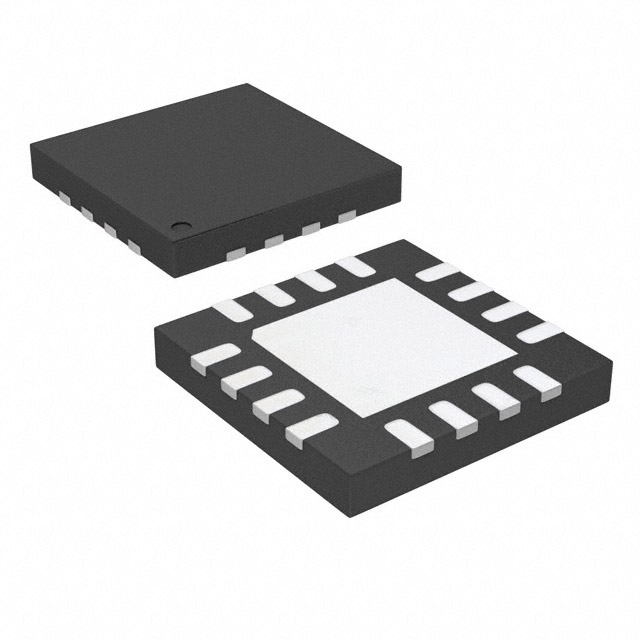Viz Specifikace pro podrobnosti o produktu.

LTC4120EUD#TRPBF
Product Overview
Category: Integrated Circuit (IC)
Use: Battery Charger
Characteristics: - High efficiency - Wide input voltage range - Programmable charging current - Automatic recharge - Thermal regulation - Overvoltage protection - Undervoltage lockout - Power good status indicator
Package: 16-Lead QFN (Quad Flat No-Lead)
Essence: The LTC4120EUD#TRPBF is a high-efficiency, wide input voltage range battery charger IC. It is designed to charge single-cell lithium-ion/polymer batteries from various power sources such as wall adapters, USB ports, or wireless power receivers.
Packaging/Quantity: The LTC4120EUD#TRPBF is available in a 16-Lead QFN package and is typically sold in reels of 2500 units.
Specifications
- Input Voltage Range: 4V to 19V
- Charging Current Range: 10mA to 400mA
- Charge Termination Voltage: 4.2V ±1%
- Operating Temperature Range: -40°C to 85°C
- Efficiency: Up to 94%
Pin Configuration
The LTC4120EUD#TRPBF has the following pin configuration:
- VOUT: Output Voltage
- GND: Ground
- PROG: Programming Pin
- EN: Enable Pin
- PG: Power Good Indicator
- ISET: Charging Current Set Pin
- BAT: Battery Connection
- TS: Thermal Shutdown Pin
- VIN: Input Voltage
- N/C: Not Connected
- N/C: Not Connected
- N/C: Not Connected
- N/C: Not Connected
- N/C: Not Connected
- N/C: Not Connected
- N/C: Not Connected
Functional Features
- Programmable charging current allows flexibility in battery charging.
- Automatic recharge feature ensures continuous charging when the battery voltage drops below a certain threshold.
- Thermal regulation prevents overheating of the IC during charging.
- Overvoltage protection safeguards the battery from excessive voltage levels.
- Undervoltage lockout prevents charging when the input voltage is too low.
- Power good status indicator provides visual feedback on the charging status.
Advantages and Disadvantages
Advantages: - High efficiency results in less power loss during charging. - Wide input voltage range allows compatibility with various power sources. - Programmable charging current enables customization based on battery requirements. - Automatic recharge feature ensures uninterrupted charging. - Thermal regulation protects the IC from overheating. - Overvoltage protection and undervoltage lockout enhance safety. - Power good status indicator provides user-friendly feedback.
Disadvantages: - Limited to single-cell lithium-ion/polymer battery charging. - Requires external components for complete battery charging circuitry.
Working Principles
The LTC4120EUD#TRPBF operates as a constant-current/constant-voltage charger. It regulates the charging current based on the programming set by the ISET pin. Once the battery voltage reaches the charge termination voltage, the IC switches to constant-voltage mode, maintaining a steady voltage across the battery terminals.
During charging, the LTC4120EUD#TRPBF monitors the battery temperature through the TS pin. If the temperature exceeds a predefined threshold, the IC reduces the charging current to prevent overheating.
The IC also incorporates overvoltage protection to safeguard the battery from excessive voltage levels. Additionally, it features an undervoltage lockout mechanism that prevents charging when the input voltage is below a certain threshold.
Detailed Application Field Plans
The LTC4120EUD#TRPBF is suitable for a wide range of applications, including: - Portable electronic devices - Wireless charging systems - Battery-powered medical devices - Industrial equipment - IoT devices
Detailed and Complete Alternative Models
Some alternative models to the LTC4120EUD#TRPBF include: - MCP73831: Single-cell Li-ion/polymer battery charger with similar features. - BQ24075: Integrated single-cell Li-ion/polymer battery charger with power path management. - MAX1555: Standalone single-cell Li-ion/polymer battery charger with thermal regulation.
These alternative models offer similar functionality and can be considered based on specific application requirements.
Word count: 468 words
Seznam 10 běžných otázek a odpovědí souvisejících s aplikací LTC4120EUD#TRPBF v technických řešeních
Sure! Here are 10 common questions and answers related to the application of LTC4120EUD#TRPBF in technical solutions:
Q: What is LTC4120EUD#TRPBF? A: LTC4120EUD#TRPBF is a wireless power receiver IC designed for applications such as wireless charging.
Q: What is the input voltage range of LTC4120EUD#TRPBF? A: The input voltage range of LTC4120EUD#TRPBF is typically between 4V and 19V.
Q: What is the maximum output current of LTC4120EUD#TRPBF? A: The maximum output current of LTC4120EUD#TRPBF is typically 400mA.
Q: Can LTC4120EUD#TRPBF be used for wireless charging of mobile devices? A: Yes, LTC4120EUD#TRPBF can be used for wireless charging of mobile devices that support wireless charging standards.
Q: Does LTC4120EUD#TRPBF support any specific wireless charging standard? A: LTC4120EUD#TRPBF supports the Qi wireless charging standard.
Q: What is the efficiency of LTC4120EUD#TRPBF? A: The efficiency of LTC4120EUD#TRPBF is typically around 80-90%.
Q: Can LTC4120EUD#TRPBF be used in automotive applications? A: Yes, LTC4120EUD#TRPBF can be used in automotive applications as long as the operating conditions are within its specified range.
Q: Is LTC4120EUD#TRPBF suitable for low-power IoT devices? A: Yes, LTC4120EUD#TRPBF is suitable for low-power IoT devices as it can provide efficient wireless power transfer.
Q: Does LTC4120EUD#TRPBF have any built-in protection features? A: Yes, LTC4120EUD#TRPBF has built-in overvoltage and overcurrent protection features to ensure safe operation.
Q: Can LTC4120EUD#TRPBF be used in a multi-device charging pad? A: Yes, LTC4120EUD#TRPBF can be used in a multi-device charging pad by connecting multiple ICs in parallel to support simultaneous charging of multiple devices.
Please note that the answers provided here are general and may vary depending on specific application requirements and conditions. It is always recommended to refer to the datasheet and consult with the manufacturer for detailed information and application-specific guidance.

